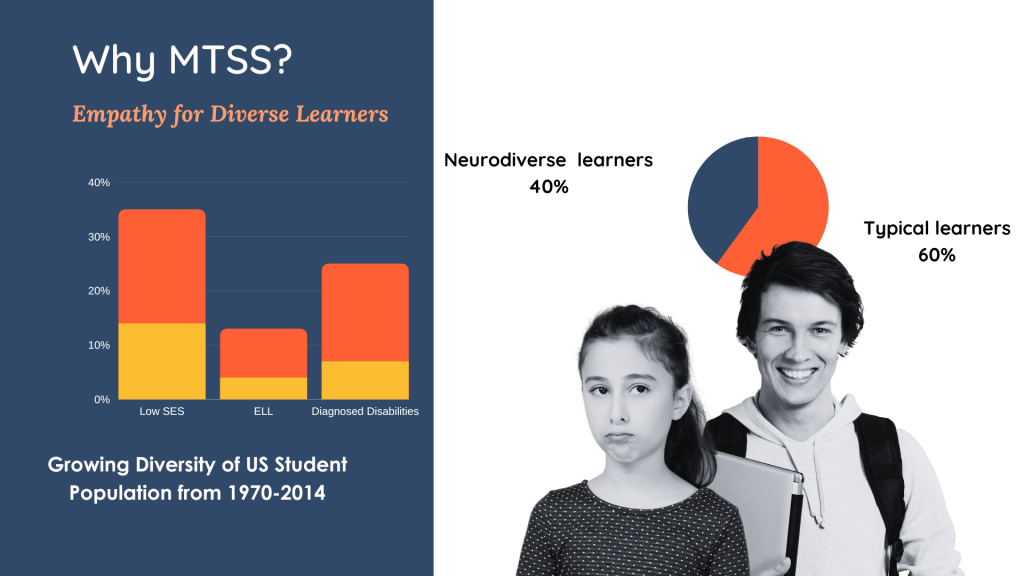Implementing MTSS requires empathy and understanding. Maybe a simple analogy will help.
Think about your car. The purpose of your car is to transport you safely from place to place. It functions as a self propelled vehicle. A car (as a whole) can move. However, if you break the car into parts it loses its ability to function and fulfill its purpose. For example, the engine alone cannot move. It has to interact with the fuel system, the braking system, the suspension system, etc. This is why a system is not the sum of its parts. That is to say the parts of a system need something to connect them so they can work together. In our car example, gasoline is the fuel that energizes the parts to interact so the car can function. Likewise, what are the critical parts that must interact so your students can move forward? In addition, what is the fuel that binds your MTSS system and takes you where you want to go?
When systems are complex like MTSS, we find it helps to use an analogy. In this post, we will explore the problem with understanding MTSS, clarify its purpose, explain how the parts interact, and make two key points about your car and MTSS. The first step is empathizing with an ever-changing environment and understanding the system that serves it.
The Problem
New state standards have introduced a paradigm shift in education from No Child Left Behind to the Every Student Succeeds Act. Meanwhile, our classrooms are increasingly diverse. An educator in the 1970s or 1980s with a classroom of 24 students might have had five or six students (20 to 34 percent) requiring specialized instruction or interventions. In a classroom of 24 students today, between 10 and 12 students (40 to 50 percent) are living in poverty, have a disability or learning difference, are English language learners, are gifted or talented, are experiencing challenges at home or in their communities that result in trauma, or some combination of the above. Subsequently, research shows each of these students needs personalized approaches to learning. But, even the most capable educator cannot meet the demand for personalization without appropriate resources and support.
To meet this new challenge, schools must shift to a different system. That system is multi tiered systems of support or MTSS. Sadly, understanding MTSS is difficult because most people focus on breaking MTSS into parts instead of focusing on consider how the parts interact.
The Purpose
The purpose of MTSS is to provide adequate response opportunities to standards based tasks for ALL students. Its function is a resource allocation to fulfill this purpose. Like the parts of a car interact to make the vehicle move, the parts of MTSS interact to provide every student just the right opportunities to respond to standards based tasks every single day. A mechanical system like a car uses fuel to energize it. On the other hand, people-based systems like MTSS run on INFORMATION.
The good news is that information is not like gasoline. Information doesn’t deplete with use like gasoline does. Rather, information GROWS knowledge which only increases as it is used. When information flows through efficient interacting parts, innovation is a natural outcome.
The Parts
- Active leadership is like your MTSS engine. Active leaders spark MTSS and set it in motion. They gauge professional development needs to drive the implementation. Leadership provides the power and keeps the system moving.
- Infrastructure and Capacity is like the car’s chassis and body. No matter how great your engine is, you won’t get anywhere without a frame to support it. In schools, the frame is time. So, schedules and plans have to support the power of the engine.
- Communication and Collaboration is the drive train. It transmits the energy to the wheels on the ground. In the case of MTSS it transmits information to classroom practice.
- Data Based Problem Solving is like the dashboard. It identifies problems and alerts you that you may need some maintenance or maybe a new part.
- Multi Tiered Systems of Support is like the suspension system. It steers instruction by responding to the road and making the necessary adjustments.
- Data Evaluation is like your car’s exhaust system. It retains what is good and uses it and it emits what is unnecessary or not useful.
The Points
First, it may not be a perfect analogy, but here is the point. None of these MTSS components works without all of the others. If you break them up, they lose their ability to function. So, develop them all together.
Second, MTSS is not a mechanical system. It is sociocultural. It actually operates less like a car and more like a family. Unlike a car, the parts change all the time based the experiences and knowledge of the participants. Like family, it can be messy and complicated. MTSS takes consistent work and that work is never done. However, if you behave as an active leader you will create a happy, successful culture that feels like a family indeed.







